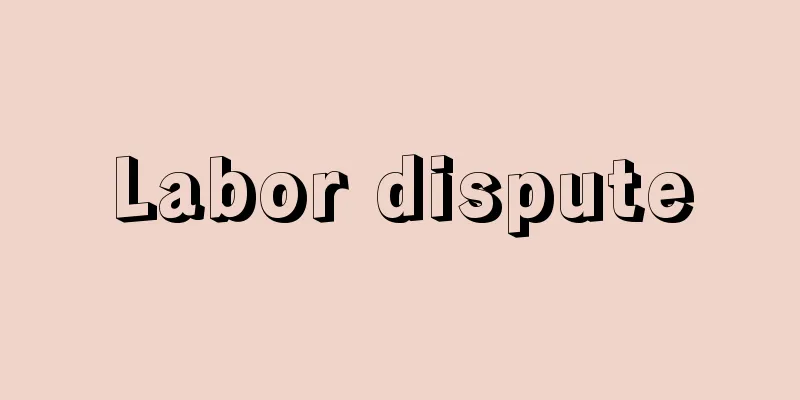Labor dispute

|
In capitalist society, conflicts arise between workers and employers (capitalists) over working conditions such as wages and working hours. In the early days of capitalist society, workers' struggles took the form of uprisings or riots, but workers came to realize that this would not get their way. As a result, workers united and negotiated working conditions and other issues with employers as a group. The state and employers suppressed and repressed this collective movement of workers (labor movement), but as the labor movement continued to grow and flourish, both the state and employers recognized the labor movement and tried to force it into the framework of the system. Labor disputes are a part of such labor movements and are a conflict between labor and management, and are inevitable in capitalist society. As labor disputes became larger in scale, the state began to intervene in labor disputes and introduced systems to mediate them. [Hiroshi Murashita and Mikio Yoshida] The Significance of Labor DisputesArticle 6 of the Labor Relations Adjustment Law (Law No. 25 of 1946, abbreviated as the Labor Relations Adjustment Law) defines a labor dispute as "a state in which the parties in a labor relationship do not agree on their claims regarding the labor relationship, and therefore a dispute action has occurred or is likely to occur." The reason why the Labor Relations Adjustment Law has this definition is because it is necessary to clarify the meaning of a labor dispute in order for the Labor Relations Commission to begin mediating a labor dispute. In other words, when the Labor Relations Commission begins mediating a labor dispute, the existence of a labor dispute as defined in the Labor Relations Adjustment Law is a prerequisite. Usually, a labor dispute occurs when collective bargaining is conducted between labor and management, and the employer rejects the demands of the labor union, or when the claims of both parties ultimately do not agree after repeated collective bargaining. Therefore, a labor dispute is one that occurs between a labor union and an employer, that is, in a collective labor relationship. A dispute between an individual worker and an employer over an issue is not called a labor dispute. However, even if a dispute concerns an individual worker, it can be considered a labor dispute if the labor union makes an institutional decision to take it up as a union. [Hiroshi Murashita and Mikio Yoshida] Requirements for Labor DisputesThe requirements for a dispute to be considered a labor dispute are as follows. First, the matter in dispute must be between a labor union and an employer. Second, the subject of the dispute must be an issue related to the maintenance and improvement of working conditions or other issues related to improving economic status. Third, the claims of both parties in the dispute must be clear. Incidentally, Article 6 of the Labor Relations Adjustment Law stipulates that a requirement for a labor dispute is that there is a "disagreement in claims regarding labor relations." In relation to the Labor Union Law, the disagreement in claims here is considered to be a disagreement regarding the maintenance and improvement of working conditions or other issues related to improving economic status. Therefore, it can be said that Article 6 of the Labor Relations Adjustment Law is attempting to exclude from the definition of a labor dispute any labor-management dispute regarding matters beyond the jurisdiction of both parties, labor and management. However, there is also the view that even a labor-management dispute regarding matters beyond the jurisdiction of the parties in labor-management relations, such as a political strike against a bad law, can be considered a labor dispute. Furthermore, when looking at labor disputes from the perspective of their purpose, there are economic disputes, which are concerned with determining the economic conditions of the labor and management parties, and rights disputes, which are concerned with determining the rights and obligations of the labor and management parties in relation to labor agreements, work rules, etc. [Hiroshi Murashita and Mikio Yoshida] Trends in labor disputesGlobally, from the 1960s to the end of the 1970s, there was a trend toward an increase in labor disputes in developed countries. However, with the globalization of the economy, factories from developed countries have been moving to developing countries, and with international price competition intensifying, labor disputes have become a phenomenon that can occur in any country in the world. Of course, the number of labor disputes varies from year to year, so it is not possible to give a fixed characteristic for each country, but in the long term, a downward trend can be seen in many countries. In Japan, the number of labor disputes was high until the 1970s, but has decreased significantly since the mid-1980s. In addition to economic trends such as stagnant economic growth and the transfer of factories overseas, the background to this is that labor unions are caught up in inter-company competition due to the company-based organizational structure, and as non-regular employment increases, the organization rate falls and they lose bargaining power. The number of strikes carried out in labor disputes has also decreased to one-tenth of what it was 10 years ago in the 10 years since 2000. Although collective labor disputes have thus decreased, on the other hand, disputes over working conditions between individual workers and employers have increased. For this reason, the Act on Promotion of Resolution of Individual Labor-Related Disputes (2001) and the Labor Tribunal Act (2004) have been enacted to resolve individual disputes. [Mikio Yoshida] Legal issues surrounding labor disputesOne is the issue of the legal assessment of industrial action carried out in the wake of a labor dispute. Issues of legitimacy and legality of industrial action are discussed from the perspective of their purpose, means, and nature. The other is the issue of state power mediating or intervening in labor disputes. The Labor Relations Adjustment Act establishes a system for mediating various types of labor disputes. While the law upholds the principle that labor and management should resolve labor disputes voluntarily, it also prescribes a system of mediation, conciliation, arbitration, and emergency adjustment as means of mediation. The administrative commissions that carry out these mediation functions are the Central Labor Relations Commission and the Prefectural Labor Relations Commissions. [Hiroshi Murashita and Mikio Yoshida] "Labor-Management Disputes and the Law" edited by Noboru Kataoka, Ryunosuke Manai, and Satoshi Nishitani (1995, Yuhikaku)" ▽ "Labor Union Law, by Satoshi Nishitani, 2nd Edition (2006, Yuhikaku)" ▽ "Labor Disputes, by Tadashi Hanami (Kodansha Academic Library)" [Reference items] | | | | | | | | | | |Source: Shogakukan Encyclopedia Nipponica About Encyclopedia Nipponica Information | Legend |
|
資本主義社会において、労働者と使用者(資本家)が賃金、労働時間などの労働条件をめぐって起こす対立抗争。資本主義社会の初期には、労働者の闘争は一揆(いっき)あるいは暴動の形態をとっていたが、それでは労働者の主張を貫徹できないことを労働者は自覚するようになる。そこで労働者は団結して集団で使用者と労働条件などを取引するようになる。この労働者の集団的運動(労働運動)に対して、国家および使用者は弾圧・抑圧することになるが、労働運動の高揚・継続のなかで、国家も使用者も労働運動を承認し体制の枠の中に押し込めようとする。このような労働運動の一部を構成する労使間の紛争が労働争議であり、これは資本主義社会においては必然的なものである。そこでとくに労働争議が大規模になるにつれて、国家は労働争議に介入し、労働争議を調整する制度を導入するに至る。 [村下 博・吉田美喜夫] 労働争議の意義労働関係調整法(昭和21年法律第25号。略称、労調法)第6条は、労働争議の定義として「労働関係の当事者間において、労働関係に関する主張が一致しないで、そのために争議行為が発生してゐる状態又は発生する虞(おそれ)がある状態をいふ」と規定している。労調法がこの定義を定めているのは、労働争議の意味を明確にしておくことが労働委員会による労働争議の調整の開始に必要だからである。すなわち、労働委員会の調整開始の際に、労調法に定める労働争議の存在が前提となるからである。通常、労働争議が発生する状況としては、労使間で団体交渉が行われた結果、使用者が労働組合の要求を拒否する場合、あるいは労使双方が団交を重ねた結果、最終的に双方の主張が一致しない場合が考えられる。したがって労働争議は、労働組合と使用者との間で、すなわち集団的労働関係において発生するものをいう。一労働者個人の問題で使用者と紛争が生じても労働争議とはよばない。ただし労働者個人にかかわる紛争であっても、労働組合が機関決定を行って組合として取り上げた場合には労働争議といえる。 [村下 博・吉田美喜夫] 労働争議の要件労働争議といえるための要件としては次のことがあげられる。第一に、紛争事項が労働組合と使用者との間のものであること、第二に、紛争の対象が労働条件の維持改善その他経済的地位の向上に関連する問題であること、第三に、紛争当事者双方の主張が明白であること、である。ところで、労働関係調整法第6条は、労働争議の要件として「労働関係に関する主張が一致しない」ことと定めているが、ここでいう主張の不一致とは、労働組合法との関連でみれば労働条件の維持改善その他経済的地位の向上に関しての不一致と考えられる。したがって労調法第6条は、労使双方の当事者の権限外の事柄に関する労使紛争を労働争議の定義から外そうとしているといえる。しかし、たとえば政治ストである悪法反対ストのように、たとえ労使関係の当事者の権限外の事柄に関する労使紛争であっても労働争議に該当するという考え方もある。さらに労働争議をその目的からみると、労使当事者の経済条件を確定することにかかわる経済争議と、労働協約や就業規則などに関連して労使当事者の権利義務関係を確定することにかかわる権利争議とがある。 [村下 博・吉田美喜夫] 労働争議の動向世界的にみると、1960年代以降1970年代末までは、先進各国で労働争議の増加傾向が認められた。しかし、経済のグローバル化により先進国から開発途上国へ工場進出が行われ、また国際的な価格競争が激化するなかで、労働争議も世界のどの国でも起こりうる現象になっている。もっとも、労働争議の件数は年ごとで変動があるので、各国について固定した特徴づけができるわけではないが、長期的にみれば、多くの国で減少傾向が認められる。日本の場合も、1970年代までは労働争議の件数は多かったが、1980年代のなかば以降、顕著に減少している。経済成長の停滞、工場の海外移転という経済動向のほか、企業別組織形態であることから労働組合が企業間競争に巻き込まれるとともに、非正規雇用が増大するにつれて組織率が低下し、交渉力を失ってきていることが背景になっている。労働争議において実施されるストライキの件数も、2000年以降の10年で10分の1にまで減少している。このように集団的な労働争議は減少しているが、他方、個別の労働者と使用者との間の労働条件をめぐる紛争は増加している。そのため、個別労働関係紛争解決促進法(2001)や労働審判法(2004)などを制定して個別紛争の解決が図られている。 [吉田美喜夫] 労働争議をめぐる法律問題一つは、労働争議に伴い実行される争議行為に対する法的評価の問題である。争議行為については、その目的・手段・態様の側面から、正当性・合法性の問題が論じられている。もう一つは、労働争議に対する国家権力による調整あるいは介入の問題である。労働関係調整法は、各種の労働争議の調整に関する制度を設けている。同法は、労働争議の労使間における自主的解決を原則としつつ、調整手段として、斡旋(あっせん)、調停、仲裁、緊急調整という制度を定めている。これらの調整機能を果たす行政委員会として、中央労働委員会、都道府県労働委員会がある。 [村下 博・吉田美喜夫] 『片岡曻・萬井隆令・西谷敏編『労使紛争と法』(1995・有斐閣)』▽『西谷敏著『労働組合法』第2版(2006・有斐閣)』▽『花見忠著『労働争議』(講談社学術文庫)』 [参照項目] | | | | | | | | | | |出典 小学館 日本大百科全書(ニッポニカ)日本大百科全書(ニッポニカ)について 情報 | 凡例 |
<<: Labor Dispute Adjustment System
Recommend
Counting - Kazutori
[Noun] (Suru) Counting by 1 . "Doyō-ushi Day ...
kulintang
...In the southern islands of Mindanao and the Su...
Izanami-no-Mikoto
In Japanese mythology, Izanagi Izanagi no Mikoto S...
Samurai bond
Publicly offered bonds denominated in yen issued b...
Petrescu, Cezar
… [20th century] In the early 20th century, the p...
Kisokei - Kisokei
→Obai Source: Shogakukan Encyclopedia Nipponica A...
Simon Magus
Born in the Samaritan village of Cathay, Simon was...
Nakaza - Nakaza
[1] [noun] ① the central seat. The center of a row...
Salon des Tuilerie (English name)
In 1863, the Salon des refusés was held for those...
Nine-pronged vajra - Kukosho
〘Noun〙 Buddhist term. One of the Buddhist implemen...
Electromagnetic darkroom
Also known as an anechoic chamber. It is equivalen...
Accounts receivable - Sales credit
Generally, the term credit refers to a right that ...
"Colored Fairy Tales" - Colored Fairy Tales
…This work is said to have formed the basic struc...
P & O Steamship Company - P & O Steamship
The abbreviation for the British shipping company ...
Instrumental conditioning
...Therefore, conditioning can occur even if the ...



![Kamisu [town] - Kamisu](/upload/images/67cb3f1b41142.webp)





